Corporate Strategy Analysis of Sainsbury's: A Detailed Report
VerifiedAdded on 2021/02/21
|17
|5350
|194
Report
AI Summary
This report provides a comprehensive analysis of Sainsbury's corporate strategy. It begins with an introduction defining corporate strategy and its importance, followed by an external analysis utilizing PESTLE and Porter's Five Forces to assess the industry's attractiveness and the impact of political, economic, social, technological, legal, and environmental factors. The internal analysis employs TOWS, value chain, and VRIO frameworks to evaluate Sainsbury's strengths, weaknesses, opportunities, and threats, along with its resources and capabilities. The evaluation section assesses the suitability, acceptability, and feasibility of the strategies. The report concludes by summarizing the key findings and provides references and appendices, including an Ansoff Matrix for strategic options. The report provides a detailed understanding of Sainsbury's strategic positioning within the UK retail sector.
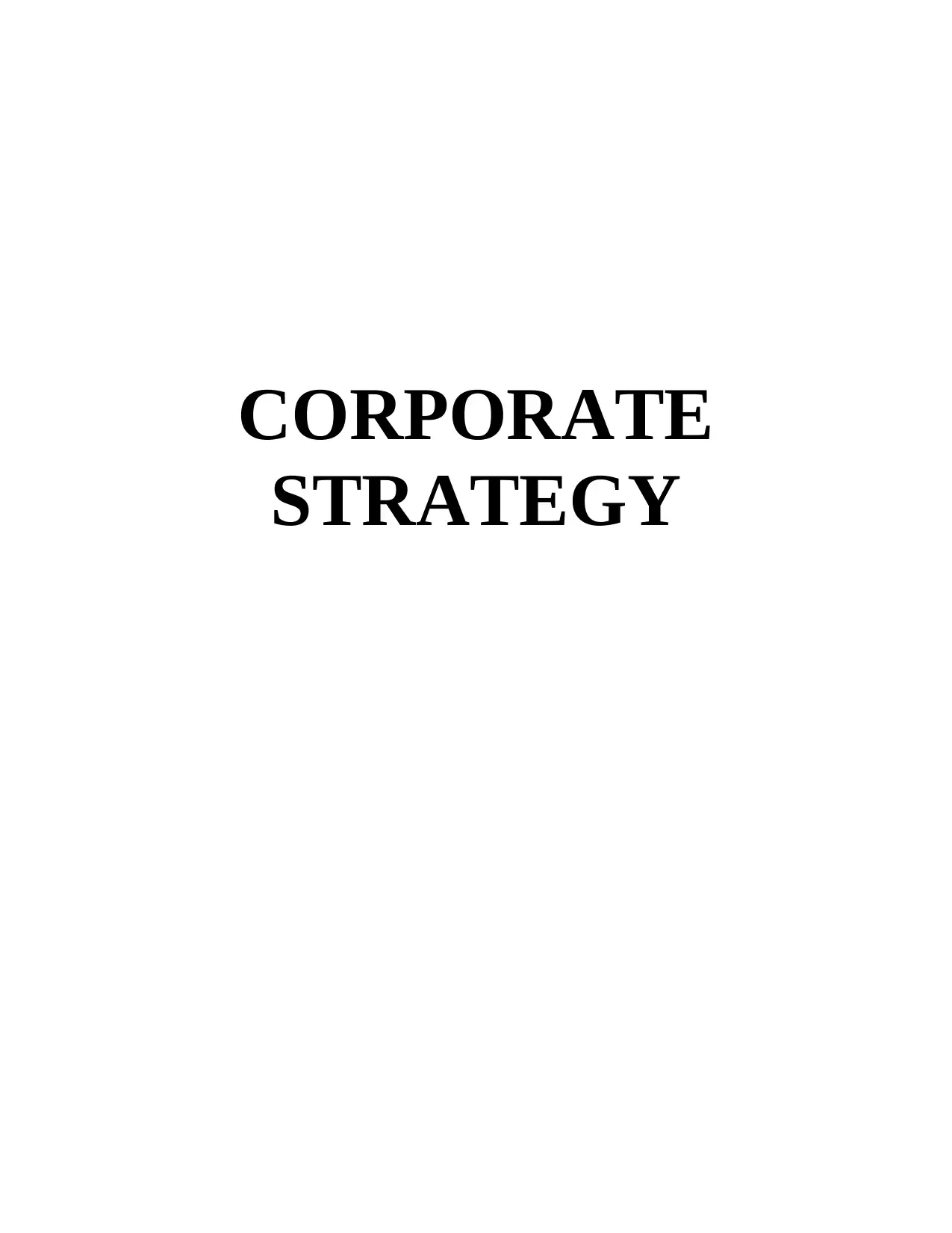
CORPORATE
STRATEGY
STRATEGY
Paraphrase This Document
Need a fresh take? Get an instant paraphrase of this document with our AI Paraphraser
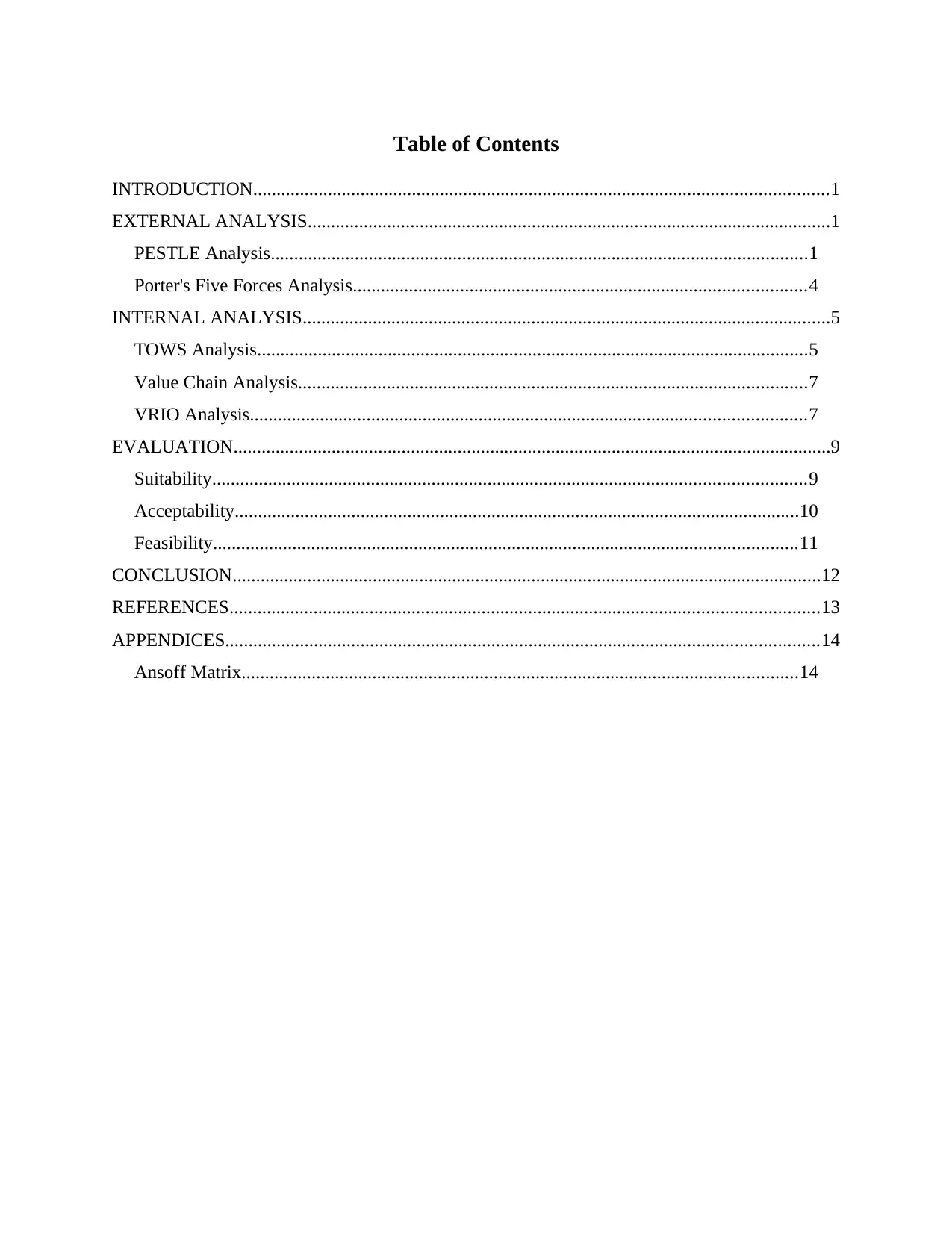
Table of Contents
INTRODUCTION...........................................................................................................................1
EXTERNAL ANALYSIS................................................................................................................1
PESTLE Analysis...................................................................................................................1
Porter's Five Forces Analysis.................................................................................................4
INTERNAL ANALYSIS.................................................................................................................5
TOWS Analysis......................................................................................................................5
Value Chain Analysis.............................................................................................................7
VRIO Analysis.......................................................................................................................7
EVALUATION................................................................................................................................9
Suitability...............................................................................................................................9
Acceptability.........................................................................................................................10
Feasibility.............................................................................................................................11
CONCLUSION..............................................................................................................................12
REFERENCES..............................................................................................................................13
APPENDICES...............................................................................................................................14
Ansoff Matrix.......................................................................................................................14
INTRODUCTION...........................................................................................................................1
EXTERNAL ANALYSIS................................................................................................................1
PESTLE Analysis...................................................................................................................1
Porter's Five Forces Analysis.................................................................................................4
INTERNAL ANALYSIS.................................................................................................................5
TOWS Analysis......................................................................................................................5
Value Chain Analysis.............................................................................................................7
VRIO Analysis.......................................................................................................................7
EVALUATION................................................................................................................................9
Suitability...............................................................................................................................9
Acceptability.........................................................................................................................10
Feasibility.............................................................................................................................11
CONCLUSION..............................................................................................................................12
REFERENCES..............................................................................................................................13
APPENDICES...............................................................................................................................14
Ansoff Matrix.......................................................................................................................14
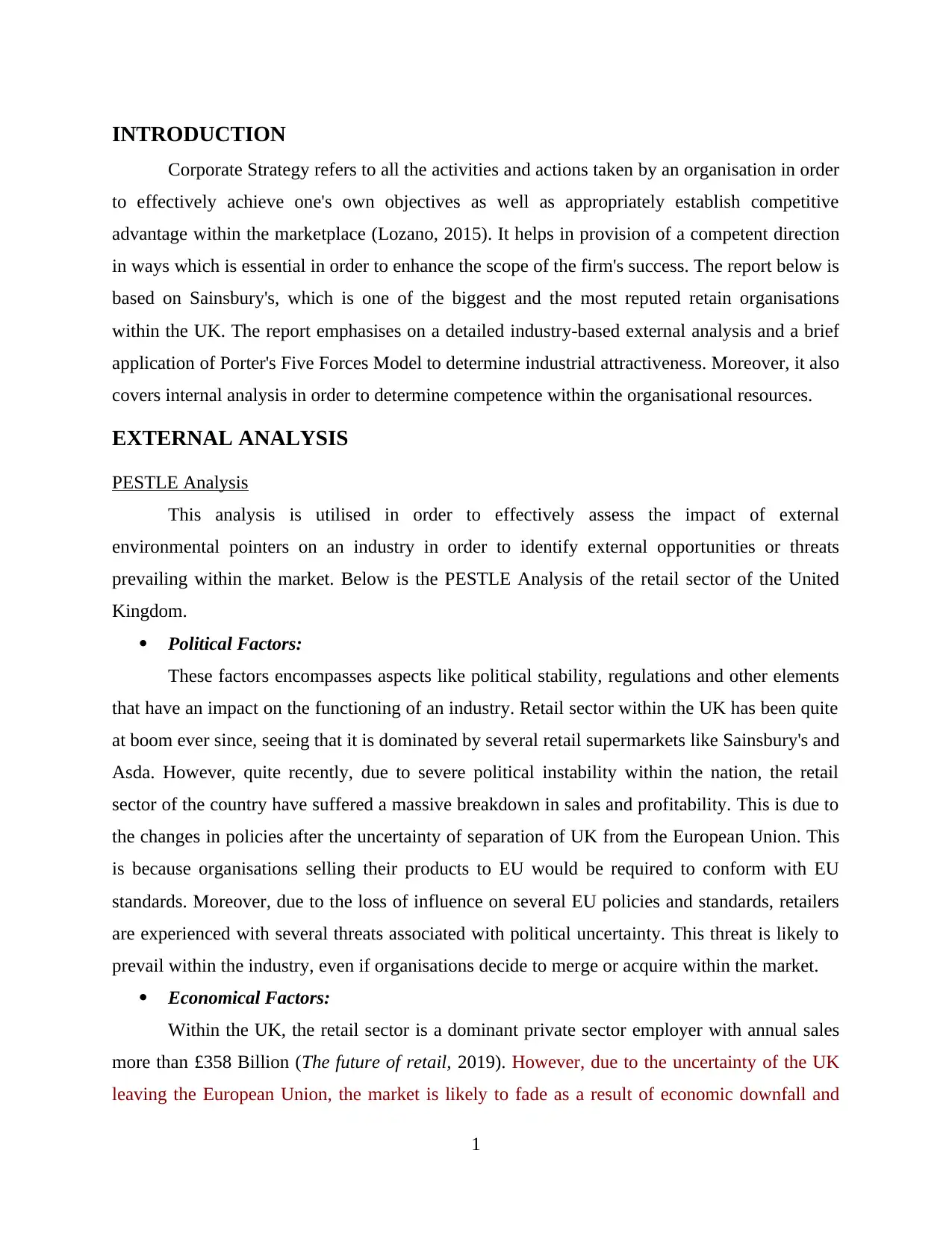
INTRODUCTION
Corporate Strategy refers to all the activities and actions taken by an organisation in order
to effectively achieve one's own objectives as well as appropriately establish competitive
advantage within the marketplace (Lozano, 2015). It helps in provision of a competent direction
in ways which is essential in order to enhance the scope of the firm's success. The report below is
based on Sainsbury's, which is one of the biggest and the most reputed retain organisations
within the UK. The report emphasises on a detailed industry-based external analysis and a brief
application of Porter's Five Forces Model to determine industrial attractiveness. Moreover, it also
covers internal analysis in order to determine competence within the organisational resources.
EXTERNAL ANALYSIS
PESTLE Analysis
This analysis is utilised in order to effectively assess the impact of external
environmental pointers on an industry in order to identify external opportunities or threats
prevailing within the market. Below is the PESTLE Analysis of the retail sector of the United
Kingdom.
Political Factors:
These factors encompasses aspects like political stability, regulations and other elements
that have an impact on the functioning of an industry. Retail sector within the UK has been quite
at boom ever since, seeing that it is dominated by several retail supermarkets like Sainsbury's and
Asda. However, quite recently, due to severe political instability within the nation, the retail
sector of the country have suffered a massive breakdown in sales and profitability. This is due to
the changes in policies after the uncertainty of separation of UK from the European Union. This
is because organisations selling their products to EU would be required to conform with EU
standards. Moreover, due to the loss of influence on several EU policies and standards, retailers
are experienced with several threats associated with political uncertainty. This threat is likely to
prevail within the industry, even if organisations decide to merge or acquire within the market.
Economical Factors:
Within the UK, the retail sector is a dominant private sector employer with annual sales
more than £358 Billion (The future of retail, 2019). However, due to the uncertainty of the UK
leaving the European Union, the market is likely to fade as a result of economic downfall and
1
Corporate Strategy refers to all the activities and actions taken by an organisation in order
to effectively achieve one's own objectives as well as appropriately establish competitive
advantage within the marketplace (Lozano, 2015). It helps in provision of a competent direction
in ways which is essential in order to enhance the scope of the firm's success. The report below is
based on Sainsbury's, which is one of the biggest and the most reputed retain organisations
within the UK. The report emphasises on a detailed industry-based external analysis and a brief
application of Porter's Five Forces Model to determine industrial attractiveness. Moreover, it also
covers internal analysis in order to determine competence within the organisational resources.
EXTERNAL ANALYSIS
PESTLE Analysis
This analysis is utilised in order to effectively assess the impact of external
environmental pointers on an industry in order to identify external opportunities or threats
prevailing within the market. Below is the PESTLE Analysis of the retail sector of the United
Kingdom.
Political Factors:
These factors encompasses aspects like political stability, regulations and other elements
that have an impact on the functioning of an industry. Retail sector within the UK has been quite
at boom ever since, seeing that it is dominated by several retail supermarkets like Sainsbury's and
Asda. However, quite recently, due to severe political instability within the nation, the retail
sector of the country have suffered a massive breakdown in sales and profitability. This is due to
the changes in policies after the uncertainty of separation of UK from the European Union. This
is because organisations selling their products to EU would be required to conform with EU
standards. Moreover, due to the loss of influence on several EU policies and standards, retailers
are experienced with several threats associated with political uncertainty. This threat is likely to
prevail within the industry, even if organisations decide to merge or acquire within the market.
Economical Factors:
Within the UK, the retail sector is a dominant private sector employer with annual sales
more than £358 Billion (The future of retail, 2019). However, due to the uncertainty of the UK
leaving the European Union, the market is likely to fade as a result of economic downfall and
1
⊘ This is a preview!⊘
Do you want full access?
Subscribe today to unlock all pages.

Trusted by 1+ million students worldwide
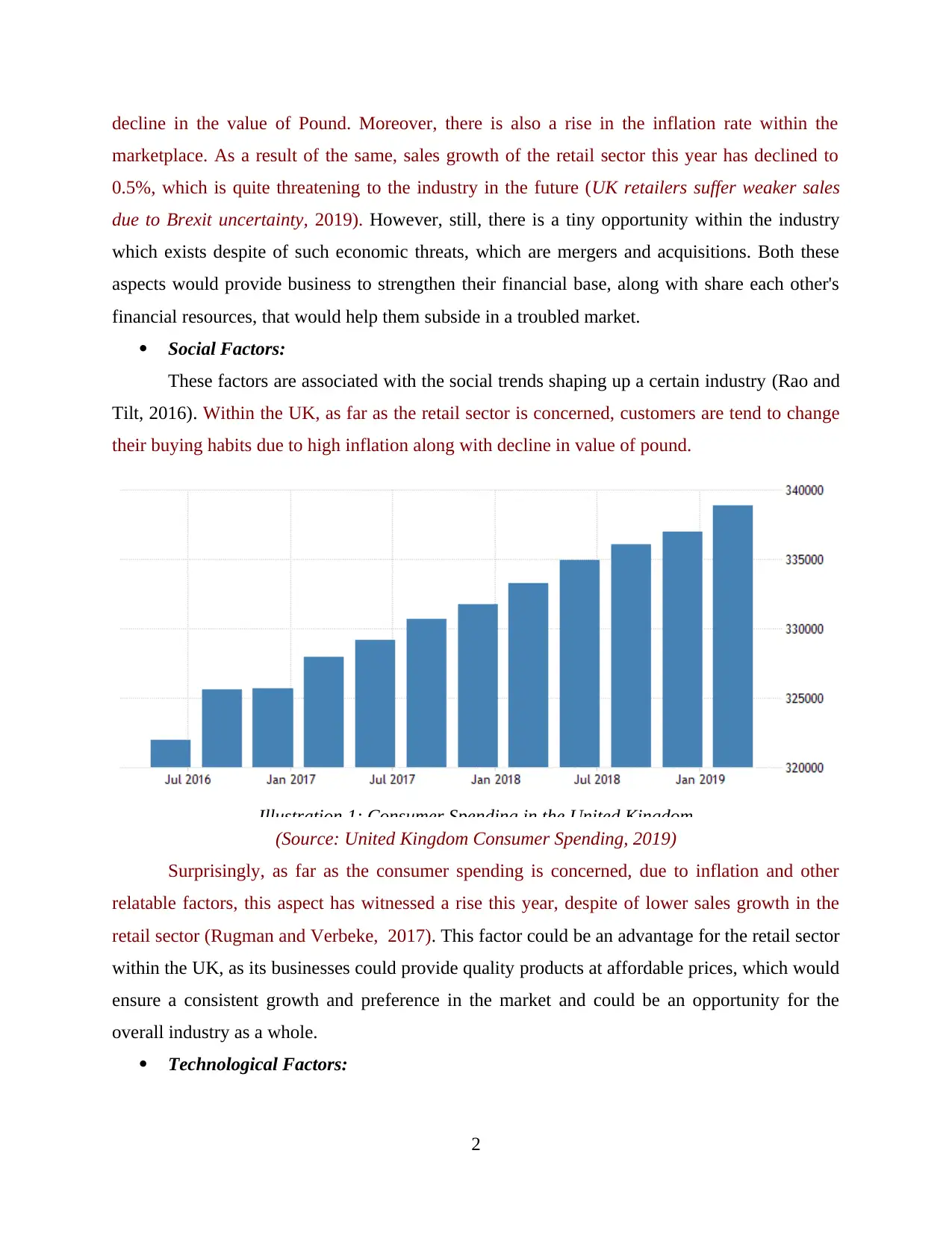
decline in the value of Pound. Moreover, there is also a rise in the inflation rate within the
marketplace. As a result of the same, sales growth of the retail sector this year has declined to
0.5%, which is quite threatening to the industry in the future (UK retailers suffer weaker sales
due to Brexit uncertainty, 2019). However, still, there is a tiny opportunity within the industry
which exists despite of such economic threats, which are mergers and acquisitions. Both these
aspects would provide business to strengthen their financial base, along with share each other's
financial resources, that would help them subside in a troubled market.
Social Factors:
These factors are associated with the social trends shaping up a certain industry (Rao and
Tilt, 2016). Within the UK, as far as the retail sector is concerned, customers are tend to change
their buying habits due to high inflation along with decline in value of pound.
Illustration 1: Consumer Spending in the United Kingdom
(Source: United Kingdom Consumer Spending, 2019)
Surprisingly, as far as the consumer spending is concerned, due to inflation and other
relatable factors, this aspect has witnessed a rise this year, despite of lower sales growth in the
retail sector (Rugman and Verbeke, 2017). This factor could be an advantage for the retail sector
within the UK, as its businesses could provide quality products at affordable prices, which would
ensure a consistent growth and preference in the market and could be an opportunity for the
overall industry as a whole.
Technological Factors:
2
marketplace. As a result of the same, sales growth of the retail sector this year has declined to
0.5%, which is quite threatening to the industry in the future (UK retailers suffer weaker sales
due to Brexit uncertainty, 2019). However, still, there is a tiny opportunity within the industry
which exists despite of such economic threats, which are mergers and acquisitions. Both these
aspects would provide business to strengthen their financial base, along with share each other's
financial resources, that would help them subside in a troubled market.
Social Factors:
These factors are associated with the social trends shaping up a certain industry (Rao and
Tilt, 2016). Within the UK, as far as the retail sector is concerned, customers are tend to change
their buying habits due to high inflation along with decline in value of pound.
Illustration 1: Consumer Spending in the United Kingdom
(Source: United Kingdom Consumer Spending, 2019)
Surprisingly, as far as the consumer spending is concerned, due to inflation and other
relatable factors, this aspect has witnessed a rise this year, despite of lower sales growth in the
retail sector (Rugman and Verbeke, 2017). This factor could be an advantage for the retail sector
within the UK, as its businesses could provide quality products at affordable prices, which would
ensure a consistent growth and preference in the market and could be an opportunity for the
overall industry as a whole.
Technological Factors:
2
Paraphrase This Document
Need a fresh take? Get an instant paraphrase of this document with our AI Paraphraser
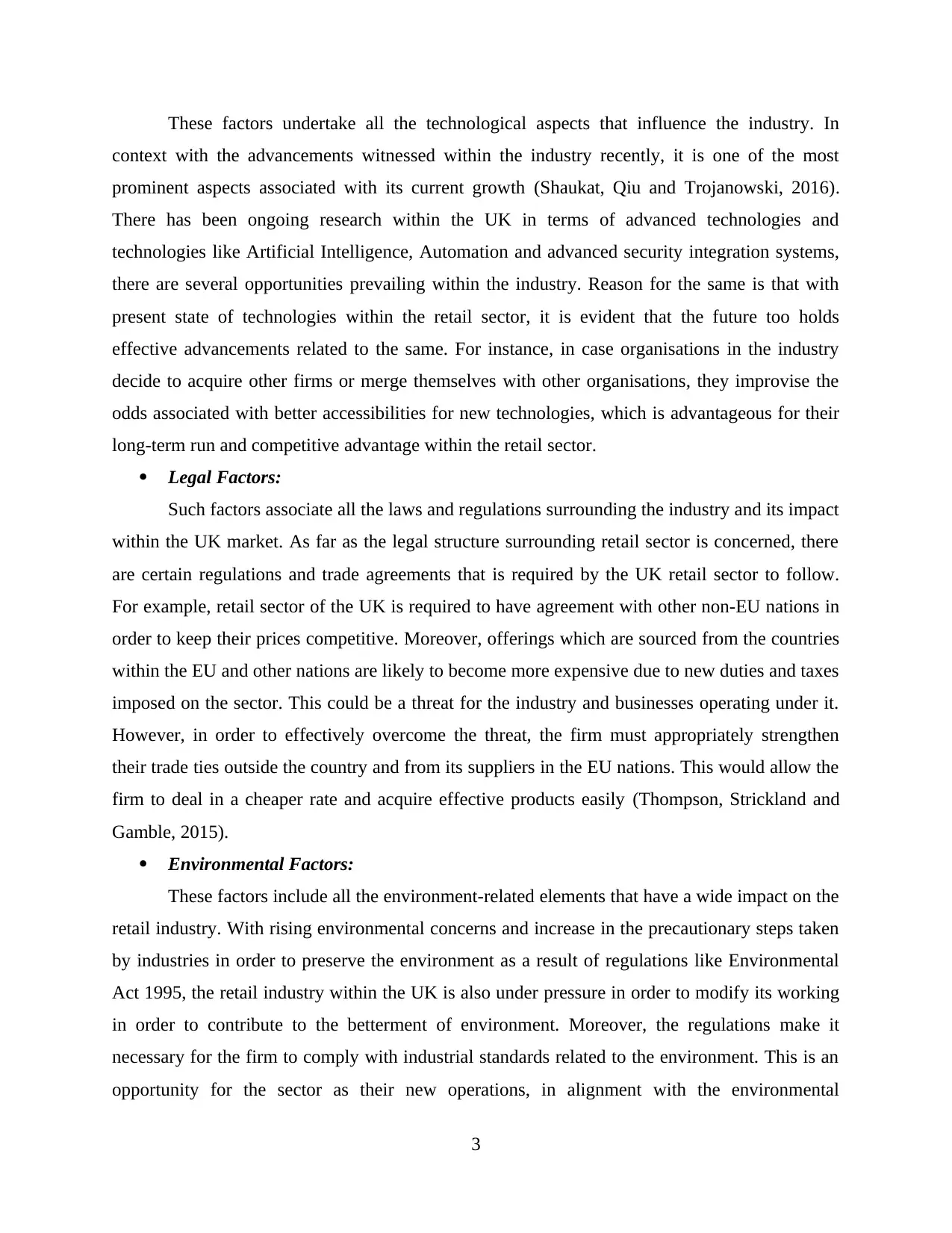
These factors undertake all the technological aspects that influence the industry. In
context with the advancements witnessed within the industry recently, it is one of the most
prominent aspects associated with its current growth (Shaukat, Qiu and Trojanowski, 2016).
There has been ongoing research within the UK in terms of advanced technologies and
technologies like Artificial Intelligence, Automation and advanced security integration systems,
there are several opportunities prevailing within the industry. Reason for the same is that with
present state of technologies within the retail sector, it is evident that the future too holds
effective advancements related to the same. For instance, in case organisations in the industry
decide to acquire other firms or merge themselves with other organisations, they improvise the
odds associated with better accessibilities for new technologies, which is advantageous for their
long-term run and competitive advantage within the retail sector.
Legal Factors:
Such factors associate all the laws and regulations surrounding the industry and its impact
within the UK market. As far as the legal structure surrounding retail sector is concerned, there
are certain regulations and trade agreements that is required by the UK retail sector to follow.
For example, retail sector of the UK is required to have agreement with other non-EU nations in
order to keep their prices competitive. Moreover, offerings which are sourced from the countries
within the EU and other nations are likely to become more expensive due to new duties and taxes
imposed on the sector. This could be a threat for the industry and businesses operating under it.
However, in order to effectively overcome the threat, the firm must appropriately strengthen
their trade ties outside the country and from its suppliers in the EU nations. This would allow the
firm to deal in a cheaper rate and acquire effective products easily (Thompson, Strickland and
Gamble, 2015).
Environmental Factors:
These factors include all the environment-related elements that have a wide impact on the
retail industry. With rising environmental concerns and increase in the precautionary steps taken
by industries in order to preserve the environment as a result of regulations like Environmental
Act 1995, the retail industry within the UK is also under pressure in order to modify its working
in order to contribute to the betterment of environment. Moreover, the regulations make it
necessary for the firm to comply with industrial standards related to the environment. This is an
opportunity for the sector as their new operations, in alignment with the environmental
3
context with the advancements witnessed within the industry recently, it is one of the most
prominent aspects associated with its current growth (Shaukat, Qiu and Trojanowski, 2016).
There has been ongoing research within the UK in terms of advanced technologies and
technologies like Artificial Intelligence, Automation and advanced security integration systems,
there are several opportunities prevailing within the industry. Reason for the same is that with
present state of technologies within the retail sector, it is evident that the future too holds
effective advancements related to the same. For instance, in case organisations in the industry
decide to acquire other firms or merge themselves with other organisations, they improvise the
odds associated with better accessibilities for new technologies, which is advantageous for their
long-term run and competitive advantage within the retail sector.
Legal Factors:
Such factors associate all the laws and regulations surrounding the industry and its impact
within the UK market. As far as the legal structure surrounding retail sector is concerned, there
are certain regulations and trade agreements that is required by the UK retail sector to follow.
For example, retail sector of the UK is required to have agreement with other non-EU nations in
order to keep their prices competitive. Moreover, offerings which are sourced from the countries
within the EU and other nations are likely to become more expensive due to new duties and taxes
imposed on the sector. This could be a threat for the industry and businesses operating under it.
However, in order to effectively overcome the threat, the firm must appropriately strengthen
their trade ties outside the country and from its suppliers in the EU nations. This would allow the
firm to deal in a cheaper rate and acquire effective products easily (Thompson, Strickland and
Gamble, 2015).
Environmental Factors:
These factors include all the environment-related elements that have a wide impact on the
retail industry. With rising environmental concerns and increase in the precautionary steps taken
by industries in order to preserve the environment as a result of regulations like Environmental
Act 1995, the retail industry within the UK is also under pressure in order to modify its working
in order to contribute to the betterment of environment. Moreover, the regulations make it
necessary for the firm to comply with industrial standards related to the environment. This is an
opportunity for the sector as their new operations, in alignment with the environmental
3
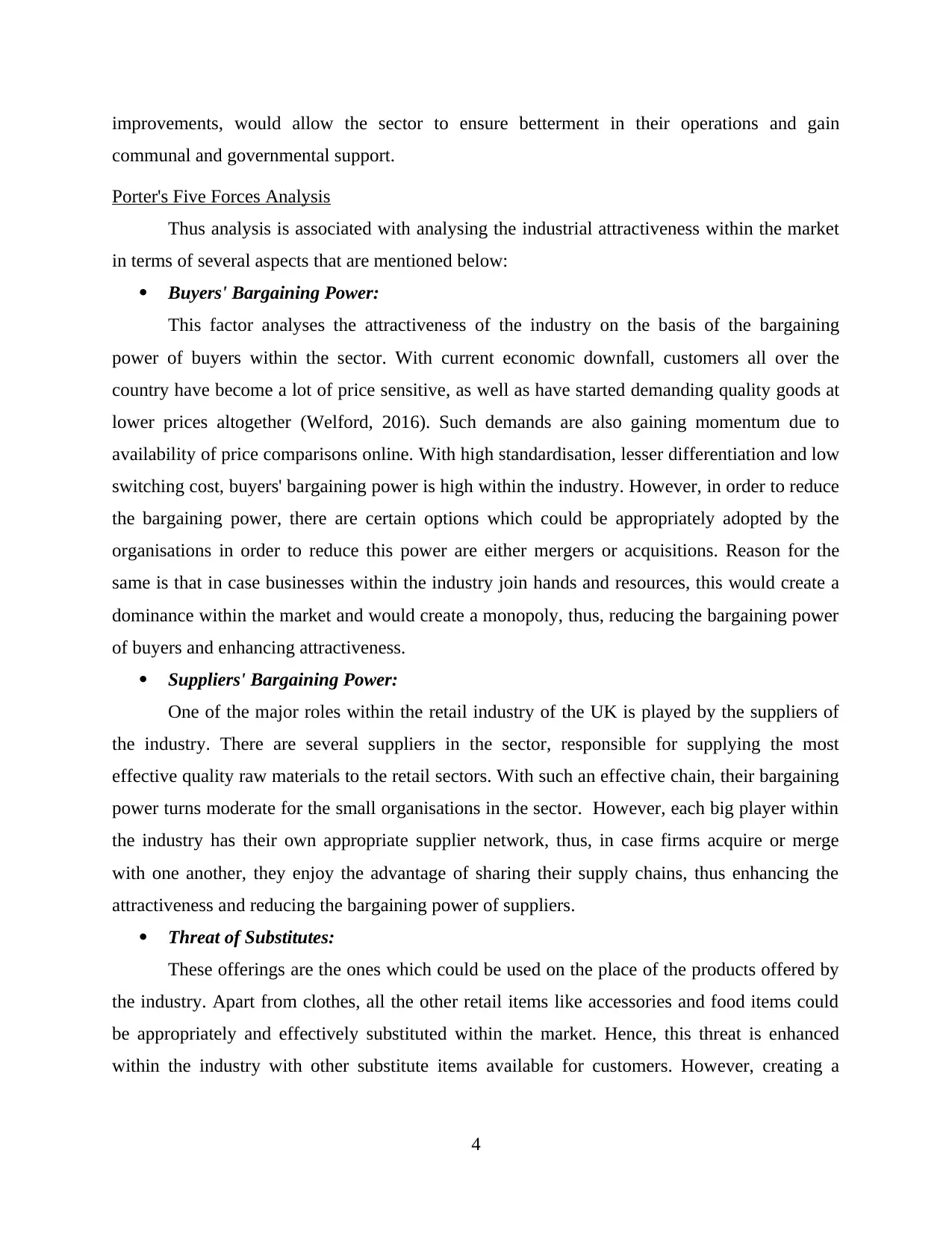
improvements, would allow the sector to ensure betterment in their operations and gain
communal and governmental support.
Porter's Five Forces Analysis
Thus analysis is associated with analysing the industrial attractiveness within the market
in terms of several aspects that are mentioned below:
Buyers' Bargaining Power:
This factor analyses the attractiveness of the industry on the basis of the bargaining
power of buyers within the sector. With current economic downfall, customers all over the
country have become a lot of price sensitive, as well as have started demanding quality goods at
lower prices altogether (Welford, 2016). Such demands are also gaining momentum due to
availability of price comparisons online. With high standardisation, lesser differentiation and low
switching cost, buyers' bargaining power is high within the industry. However, in order to reduce
the bargaining power, there are certain options which could be appropriately adopted by the
organisations in order to reduce this power are either mergers or acquisitions. Reason for the
same is that in case businesses within the industry join hands and resources, this would create a
dominance within the market and would create a monopoly, thus, reducing the bargaining power
of buyers and enhancing attractiveness.
Suppliers' Bargaining Power:
One of the major roles within the retail industry of the UK is played by the suppliers of
the industry. There are several suppliers in the sector, responsible for supplying the most
effective quality raw materials to the retail sectors. With such an effective chain, their bargaining
power turns moderate for the small organisations in the sector. However, each big player within
the industry has their own appropriate supplier network, thus, in case firms acquire or merge
with one another, they enjoy the advantage of sharing their supply chains, thus enhancing the
attractiveness and reducing the bargaining power of suppliers.
Threat of Substitutes:
These offerings are the ones which could be used on the place of the products offered by
the industry. Apart from clothes, all the other retail items like accessories and food items could
be appropriately and effectively substituted within the market. Hence, this threat is enhanced
within the industry with other substitute items available for customers. However, creating a
4
communal and governmental support.
Porter's Five Forces Analysis
Thus analysis is associated with analysing the industrial attractiveness within the market
in terms of several aspects that are mentioned below:
Buyers' Bargaining Power:
This factor analyses the attractiveness of the industry on the basis of the bargaining
power of buyers within the sector. With current economic downfall, customers all over the
country have become a lot of price sensitive, as well as have started demanding quality goods at
lower prices altogether (Welford, 2016). Such demands are also gaining momentum due to
availability of price comparisons online. With high standardisation, lesser differentiation and low
switching cost, buyers' bargaining power is high within the industry. However, in order to reduce
the bargaining power, there are certain options which could be appropriately adopted by the
organisations in order to reduce this power are either mergers or acquisitions. Reason for the
same is that in case businesses within the industry join hands and resources, this would create a
dominance within the market and would create a monopoly, thus, reducing the bargaining power
of buyers and enhancing attractiveness.
Suppliers' Bargaining Power:
One of the major roles within the retail industry of the UK is played by the suppliers of
the industry. There are several suppliers in the sector, responsible for supplying the most
effective quality raw materials to the retail sectors. With such an effective chain, their bargaining
power turns moderate for the small organisations in the sector. However, each big player within
the industry has their own appropriate supplier network, thus, in case firms acquire or merge
with one another, they enjoy the advantage of sharing their supply chains, thus enhancing the
attractiveness and reducing the bargaining power of suppliers.
Threat of Substitutes:
These offerings are the ones which could be used on the place of the products offered by
the industry. Apart from clothes, all the other retail items like accessories and food items could
be appropriately and effectively substituted within the market. Hence, this threat is enhanced
within the industry with other substitute items available for customers. However, creating a
4
⊘ This is a preview!⊘
Do you want full access?
Subscribe today to unlock all pages.

Trusted by 1+ million students worldwide
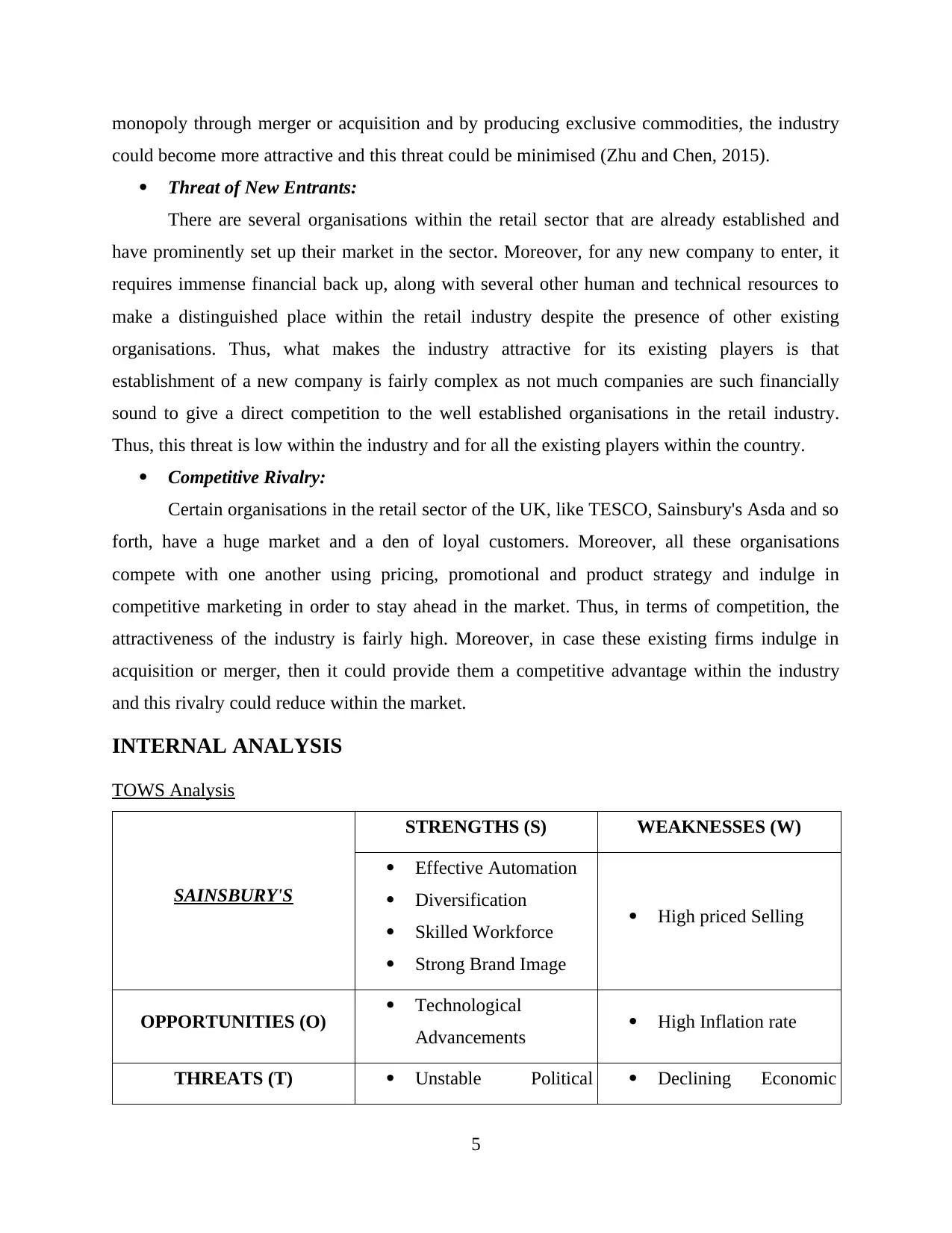
monopoly through merger or acquisition and by producing exclusive commodities, the industry
could become more attractive and this threat could be minimised (Zhu and Chen, 2015).
Threat of New Entrants:
There are several organisations within the retail sector that are already established and
have prominently set up their market in the sector. Moreover, for any new company to enter, it
requires immense financial back up, along with several other human and technical resources to
make a distinguished place within the retail industry despite the presence of other existing
organisations. Thus, what makes the industry attractive for its existing players is that
establishment of a new company is fairly complex as not much companies are such financially
sound to give a direct competition to the well established organisations in the retail industry.
Thus, this threat is low within the industry and for all the existing players within the country.
Competitive Rivalry:
Certain organisations in the retail sector of the UK, like TESCO, Sainsbury's Asda and so
forth, have a huge market and a den of loyal customers. Moreover, all these organisations
compete with one another using pricing, promotional and product strategy and indulge in
competitive marketing in order to stay ahead in the market. Thus, in terms of competition, the
attractiveness of the industry is fairly high. Moreover, in case these existing firms indulge in
acquisition or merger, then it could provide them a competitive advantage within the industry
and this rivalry could reduce within the market.
INTERNAL ANALYSIS
TOWS Analysis
SAINSBURY'S
STRENGTHS (S) WEAKNESSES (W)
Effective Automation
Diversification
Skilled Workforce
Strong Brand Image
High priced Selling
OPPORTUNITIES (O) Technological
Advancements High Inflation rate
THREATS (T) Unstable Political Declining Economic
5
could become more attractive and this threat could be minimised (Zhu and Chen, 2015).
Threat of New Entrants:
There are several organisations within the retail sector that are already established and
have prominently set up their market in the sector. Moreover, for any new company to enter, it
requires immense financial back up, along with several other human and technical resources to
make a distinguished place within the retail industry despite the presence of other existing
organisations. Thus, what makes the industry attractive for its existing players is that
establishment of a new company is fairly complex as not much companies are such financially
sound to give a direct competition to the well established organisations in the retail industry.
Thus, this threat is low within the industry and for all the existing players within the country.
Competitive Rivalry:
Certain organisations in the retail sector of the UK, like TESCO, Sainsbury's Asda and so
forth, have a huge market and a den of loyal customers. Moreover, all these organisations
compete with one another using pricing, promotional and product strategy and indulge in
competitive marketing in order to stay ahead in the market. Thus, in terms of competition, the
attractiveness of the industry is fairly high. Moreover, in case these existing firms indulge in
acquisition or merger, then it could provide them a competitive advantage within the industry
and this rivalry could reduce within the market.
INTERNAL ANALYSIS
TOWS Analysis
SAINSBURY'S
STRENGTHS (S) WEAKNESSES (W)
Effective Automation
Diversification
Skilled Workforce
Strong Brand Image
High priced Selling
OPPORTUNITIES (O) Technological
Advancements High Inflation rate
THREATS (T) Unstable Political Declining Economic
5
Paraphrase This Document
Need a fresh take? Get an instant paraphrase of this document with our AI Paraphraser
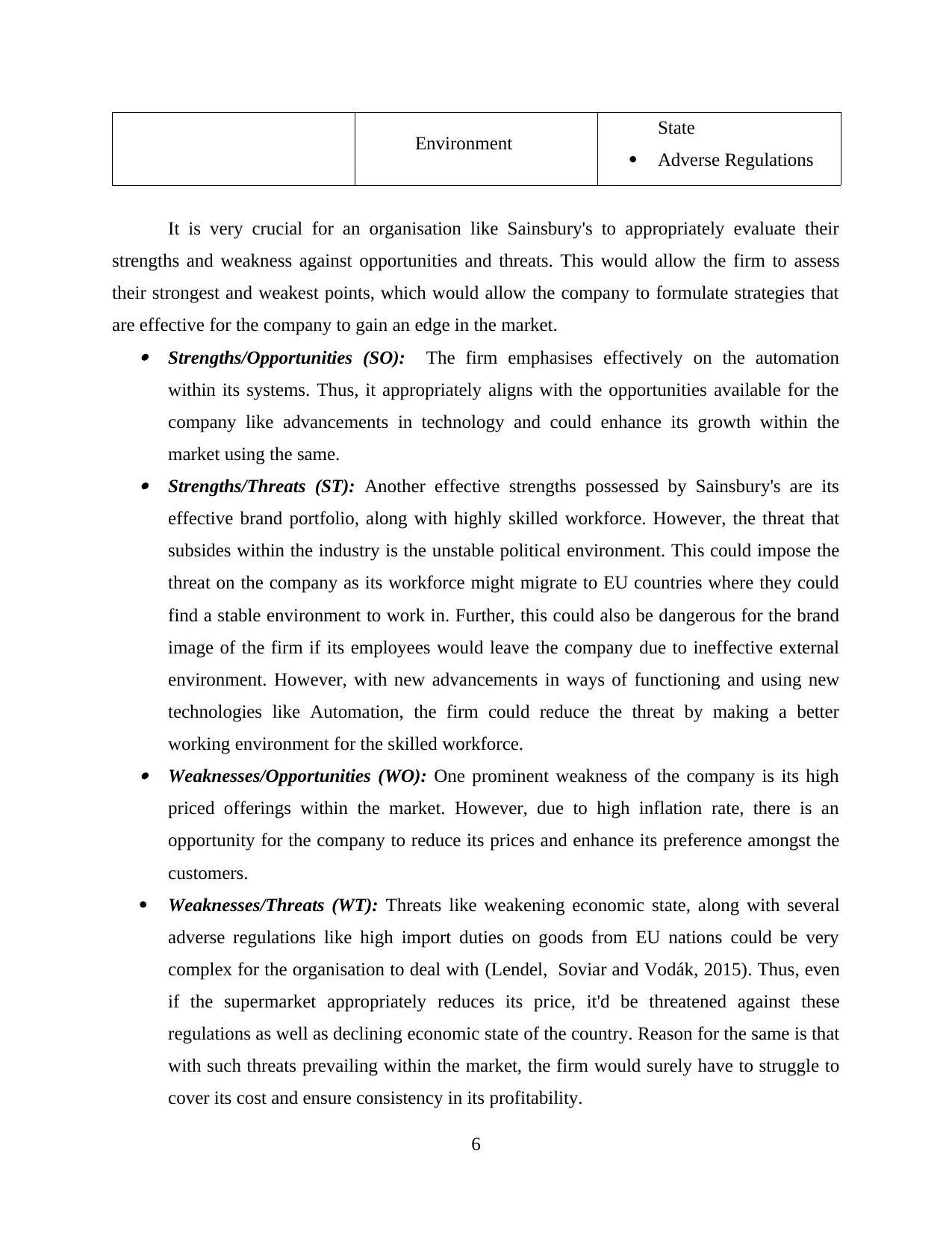
Environment State
Adverse Regulations
It is very crucial for an organisation like Sainsbury's to appropriately evaluate their
strengths and weakness against opportunities and threats. This would allow the firm to assess
their strongest and weakest points, which would allow the company to formulate strategies that
are effective for the company to gain an edge in the market. Strengths/Opportunities (SO): The firm emphasises effectively on the automation
within its systems. Thus, it appropriately aligns with the opportunities available for the
company like advancements in technology and could enhance its growth within the
market using the same. Strengths/Threats (ST): Another effective strengths possessed by Sainsbury's are its
effective brand portfolio, along with highly skilled workforce. However, the threat that
subsides within the industry is the unstable political environment. This could impose the
threat on the company as its workforce might migrate to EU countries where they could
find a stable environment to work in. Further, this could also be dangerous for the brand
image of the firm if its employees would leave the company due to ineffective external
environment. However, with new advancements in ways of functioning and using new
technologies like Automation, the firm could reduce the threat by making a better
working environment for the skilled workforce. Weaknesses/Opportunities (WO): One prominent weakness of the company is its high
priced offerings within the market. However, due to high inflation rate, there is an
opportunity for the company to reduce its prices and enhance its preference amongst the
customers.
Weaknesses/Threats (WT): Threats like weakening economic state, along with several
adverse regulations like high import duties on goods from EU nations could be very
complex for the organisation to deal with (Lendel, Soviar and Vodák, 2015). Thus, even
if the supermarket appropriately reduces its price, it'd be threatened against these
regulations as well as declining economic state of the country. Reason for the same is that
with such threats prevailing within the market, the firm would surely have to struggle to
cover its cost and ensure consistency in its profitability.
6
Adverse Regulations
It is very crucial for an organisation like Sainsbury's to appropriately evaluate their
strengths and weakness against opportunities and threats. This would allow the firm to assess
their strongest and weakest points, which would allow the company to formulate strategies that
are effective for the company to gain an edge in the market. Strengths/Opportunities (SO): The firm emphasises effectively on the automation
within its systems. Thus, it appropriately aligns with the opportunities available for the
company like advancements in technology and could enhance its growth within the
market using the same. Strengths/Threats (ST): Another effective strengths possessed by Sainsbury's are its
effective brand portfolio, along with highly skilled workforce. However, the threat that
subsides within the industry is the unstable political environment. This could impose the
threat on the company as its workforce might migrate to EU countries where they could
find a stable environment to work in. Further, this could also be dangerous for the brand
image of the firm if its employees would leave the company due to ineffective external
environment. However, with new advancements in ways of functioning and using new
technologies like Automation, the firm could reduce the threat by making a better
working environment for the skilled workforce. Weaknesses/Opportunities (WO): One prominent weakness of the company is its high
priced offerings within the market. However, due to high inflation rate, there is an
opportunity for the company to reduce its prices and enhance its preference amongst the
customers.
Weaknesses/Threats (WT): Threats like weakening economic state, along with several
adverse regulations like high import duties on goods from EU nations could be very
complex for the organisation to deal with (Lendel, Soviar and Vodák, 2015). Thus, even
if the supermarket appropriately reduces its price, it'd be threatened against these
regulations as well as declining economic state of the country. Reason for the same is that
with such threats prevailing within the market, the firm would surely have to struggle to
cover its cost and ensure consistency in its profitability.
6
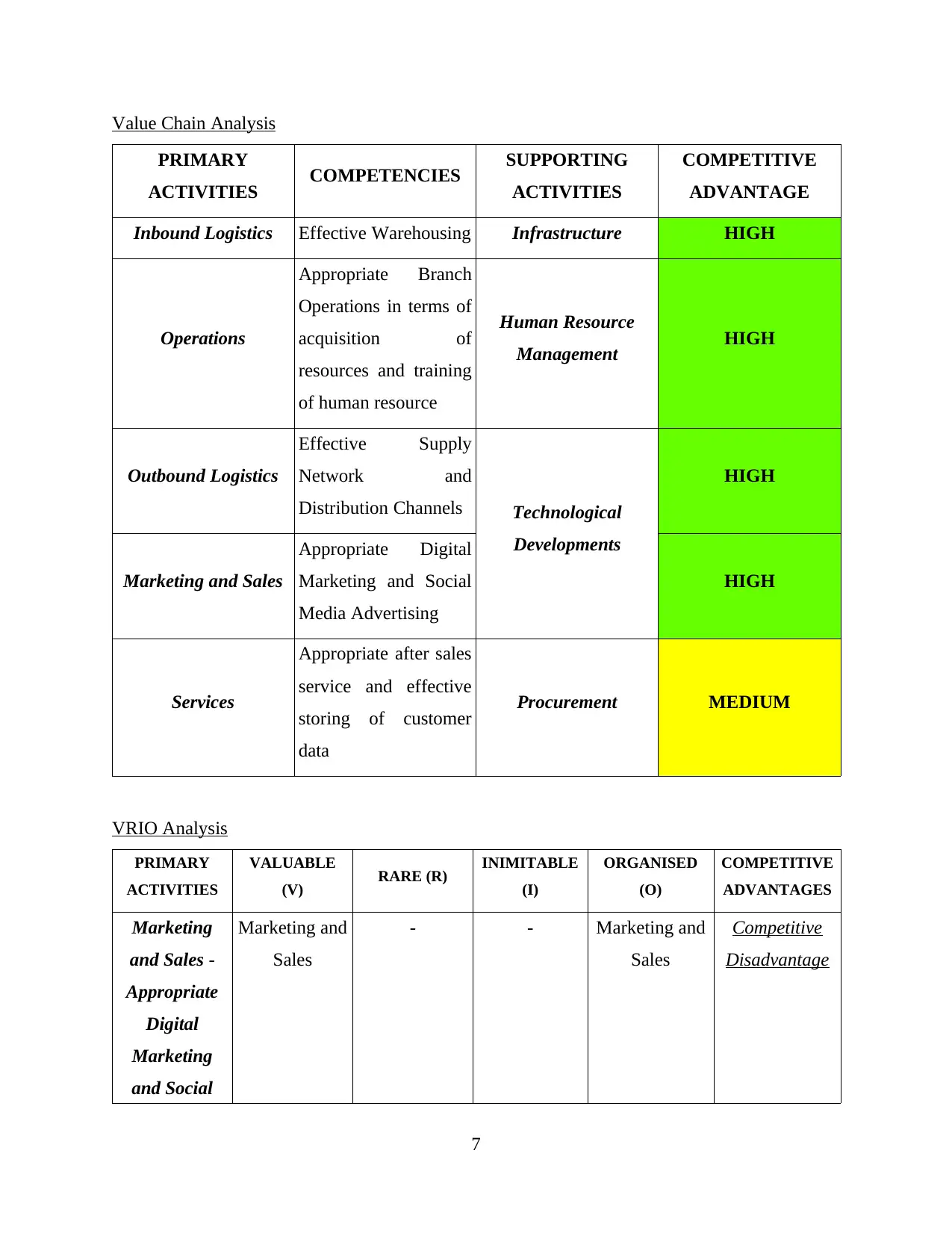
Value Chain Analysis
PRIMARY
ACTIVITIES COMPETENCIES SUPPORTING
ACTIVITIES
COMPETITIVE
ADVANTAGE
Inbound Logistics Effective Warehousing Infrastructure HIGH
Operations
Appropriate Branch
Operations in terms of
acquisition of
resources and training
of human resource
Human Resource
Management HIGH
Outbound Logistics
Effective Supply
Network and
Distribution Channels Technological
Developments
HIGH
Marketing and Sales
Appropriate Digital
Marketing and Social
Media Advertising
HIGH
Services
Appropriate after sales
service and effective
storing of customer
data
Procurement MEDIUM
VRIO Analysis
PRIMARY
ACTIVITIES
VALUABLE
(V) RARE (R) INIMITABLE
(I)
ORGANISED
(O)
COMPETITIVE
ADVANTAGES
Marketing
and Sales -
Appropriate
Digital
Marketing
and Social
Marketing and
Sales
- - Marketing and
Sales
Competitive
Disadvantage
7
PRIMARY
ACTIVITIES COMPETENCIES SUPPORTING
ACTIVITIES
COMPETITIVE
ADVANTAGE
Inbound Logistics Effective Warehousing Infrastructure HIGH
Operations
Appropriate Branch
Operations in terms of
acquisition of
resources and training
of human resource
Human Resource
Management HIGH
Outbound Logistics
Effective Supply
Network and
Distribution Channels Technological
Developments
HIGH
Marketing and Sales
Appropriate Digital
Marketing and Social
Media Advertising
HIGH
Services
Appropriate after sales
service and effective
storing of customer
data
Procurement MEDIUM
VRIO Analysis
PRIMARY
ACTIVITIES
VALUABLE
(V) RARE (R) INIMITABLE
(I)
ORGANISED
(O)
COMPETITIVE
ADVANTAGES
Marketing
and Sales -
Appropriate
Digital
Marketing
and Social
Marketing and
Sales
- - Marketing and
Sales
Competitive
Disadvantage
7
⊘ This is a preview!⊘
Do you want full access?
Subscribe today to unlock all pages.

Trusted by 1+ million students worldwide
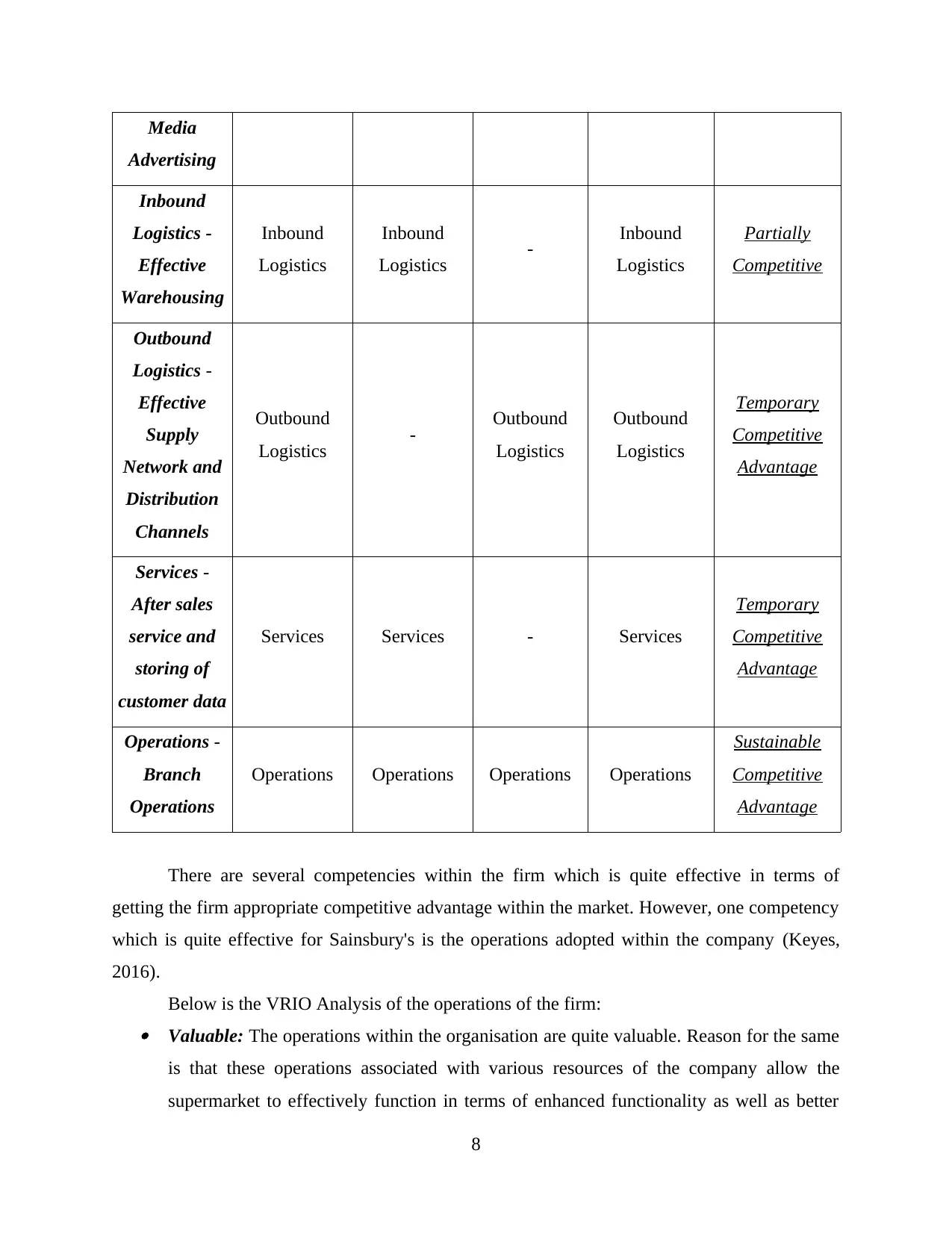
Media
Advertising
Inbound
Logistics -
Effective
Warehousing
Inbound
Logistics
Inbound
Logistics - Inbound
Logistics
Partially
Competitive
Outbound
Logistics -
Effective
Supply
Network and
Distribution
Channels
Outbound
Logistics - Outbound
Logistics
Outbound
Logistics
Temporary
Competitive
Advantage
Services -
After sales
service and
storing of
customer data
Services Services - Services
Temporary
Competitive
Advantage
Operations -
Branch
Operations
Operations Operations Operations Operations
Sustainable
Competitive
Advantage
There are several competencies within the firm which is quite effective in terms of
getting the firm appropriate competitive advantage within the market. However, one competency
which is quite effective for Sainsbury's is the operations adopted within the company (Keyes,
2016).
Below is the VRIO Analysis of the operations of the firm: Valuable: The operations within the organisation are quite valuable. Reason for the same
is that these operations associated with various resources of the company allow the
supermarket to effectively function in terms of enhanced functionality as well as better
8
Advertising
Inbound
Logistics -
Effective
Warehousing
Inbound
Logistics
Inbound
Logistics - Inbound
Logistics
Partially
Competitive
Outbound
Logistics -
Effective
Supply
Network and
Distribution
Channels
Outbound
Logistics - Outbound
Logistics
Outbound
Logistics
Temporary
Competitive
Advantage
Services -
After sales
service and
storing of
customer data
Services Services - Services
Temporary
Competitive
Advantage
Operations -
Branch
Operations
Operations Operations Operations Operations
Sustainable
Competitive
Advantage
There are several competencies within the firm which is quite effective in terms of
getting the firm appropriate competitive advantage within the market. However, one competency
which is quite effective for Sainsbury's is the operations adopted within the company (Keyes,
2016).
Below is the VRIO Analysis of the operations of the firm: Valuable: The operations within the organisation are quite valuable. Reason for the same
is that these operations associated with various resources of the company allow the
supermarket to effectively function in terms of enhanced functionality as well as better
8
Paraphrase This Document
Need a fresh take? Get an instant paraphrase of this document with our AI Paraphraser
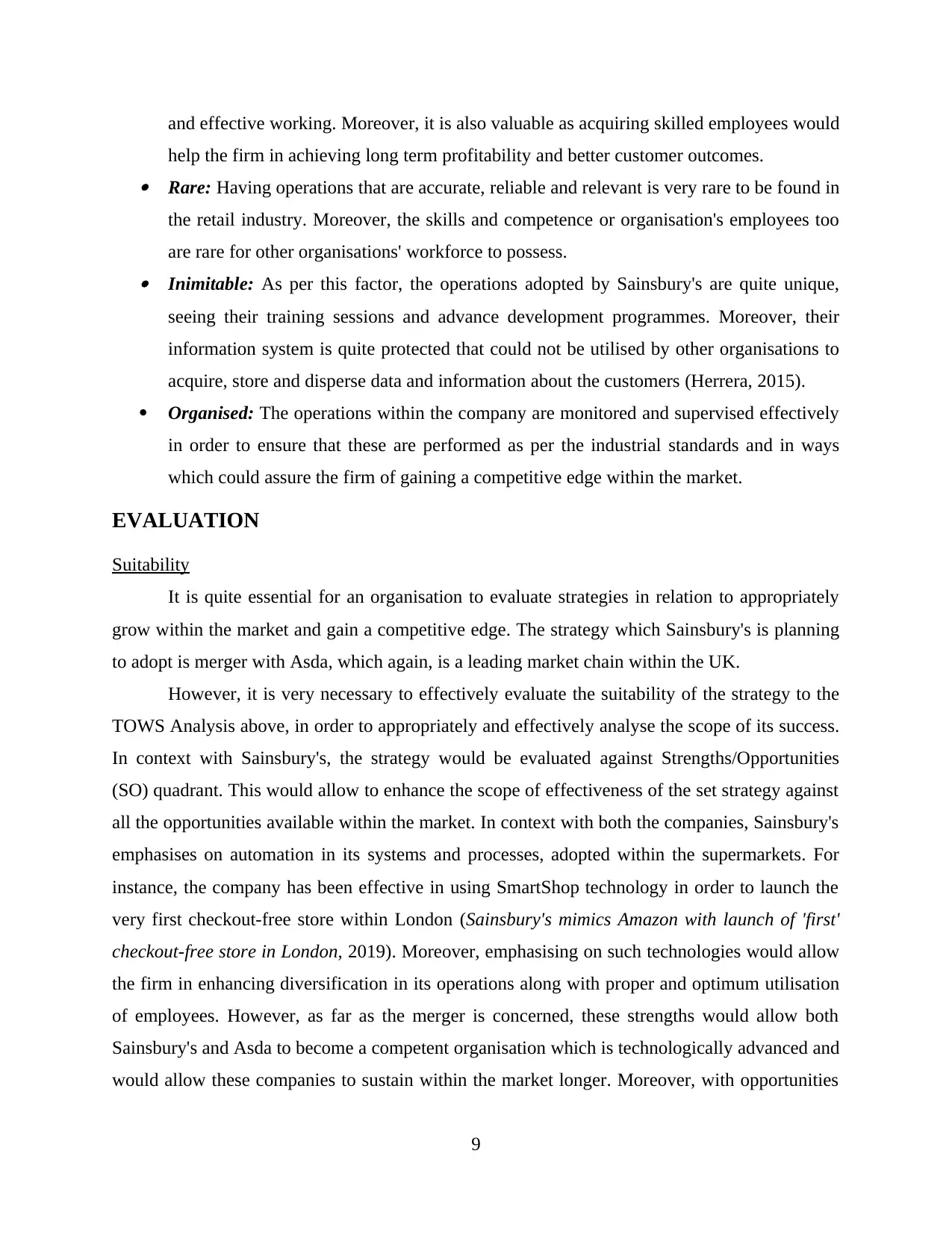
and effective working. Moreover, it is also valuable as acquiring skilled employees would
help the firm in achieving long term profitability and better customer outcomes. Rare: Having operations that are accurate, reliable and relevant is very rare to be found in
the retail industry. Moreover, the skills and competence or organisation's employees too
are rare for other organisations' workforce to possess. Inimitable: As per this factor, the operations adopted by Sainsbury's are quite unique,
seeing their training sessions and advance development programmes. Moreover, their
information system is quite protected that could not be utilised by other organisations to
acquire, store and disperse data and information about the customers (Herrera, 2015).
Organised: The operations within the company are monitored and supervised effectively
in order to ensure that these are performed as per the industrial standards and in ways
which could assure the firm of gaining a competitive edge within the market.
EVALUATION
Suitability
It is quite essential for an organisation to evaluate strategies in relation to appropriately
grow within the market and gain a competitive edge. The strategy which Sainsbury's is planning
to adopt is merger with Asda, which again, is a leading market chain within the UK.
However, it is very necessary to effectively evaluate the suitability of the strategy to the
TOWS Analysis above, in order to appropriately and effectively analyse the scope of its success.
In context with Sainsbury's, the strategy would be evaluated against Strengths/Opportunities
(SO) quadrant. This would allow to enhance the scope of effectiveness of the set strategy against
all the opportunities available within the market. In context with both the companies, Sainsbury's
emphasises on automation in its systems and processes, adopted within the supermarkets. For
instance, the company has been effective in using SmartShop technology in order to launch the
very first checkout-free store within London (Sainsbury's mimics Amazon with launch of 'first'
checkout-free store in London, 2019). Moreover, emphasising on such technologies would allow
the firm in enhancing diversification in its operations along with proper and optimum utilisation
of employees. However, as far as the merger is concerned, these strengths would allow both
Sainsbury's and Asda to become a competent organisation which is technologically advanced and
would allow these companies to sustain within the market longer. Moreover, with opportunities
9
help the firm in achieving long term profitability and better customer outcomes. Rare: Having operations that are accurate, reliable and relevant is very rare to be found in
the retail industry. Moreover, the skills and competence or organisation's employees too
are rare for other organisations' workforce to possess. Inimitable: As per this factor, the operations adopted by Sainsbury's are quite unique,
seeing their training sessions and advance development programmes. Moreover, their
information system is quite protected that could not be utilised by other organisations to
acquire, store and disperse data and information about the customers (Herrera, 2015).
Organised: The operations within the company are monitored and supervised effectively
in order to ensure that these are performed as per the industrial standards and in ways
which could assure the firm of gaining a competitive edge within the market.
EVALUATION
Suitability
It is quite essential for an organisation to evaluate strategies in relation to appropriately
grow within the market and gain a competitive edge. The strategy which Sainsbury's is planning
to adopt is merger with Asda, which again, is a leading market chain within the UK.
However, it is very necessary to effectively evaluate the suitability of the strategy to the
TOWS Analysis above, in order to appropriately and effectively analyse the scope of its success.
In context with Sainsbury's, the strategy would be evaluated against Strengths/Opportunities
(SO) quadrant. This would allow to enhance the scope of effectiveness of the set strategy against
all the opportunities available within the market. In context with both the companies, Sainsbury's
emphasises on automation in its systems and processes, adopted within the supermarkets. For
instance, the company has been effective in using SmartShop technology in order to launch the
very first checkout-free store within London (Sainsbury's mimics Amazon with launch of 'first'
checkout-free store in London, 2019). Moreover, emphasising on such technologies would allow
the firm in enhancing diversification in its operations along with proper and optimum utilisation
of employees. However, as far as the merger is concerned, these strengths would allow both
Sainsbury's and Asda to become a competent organisation which is technologically advanced and
would allow these companies to sustain within the market longer. Moreover, with opportunities
9
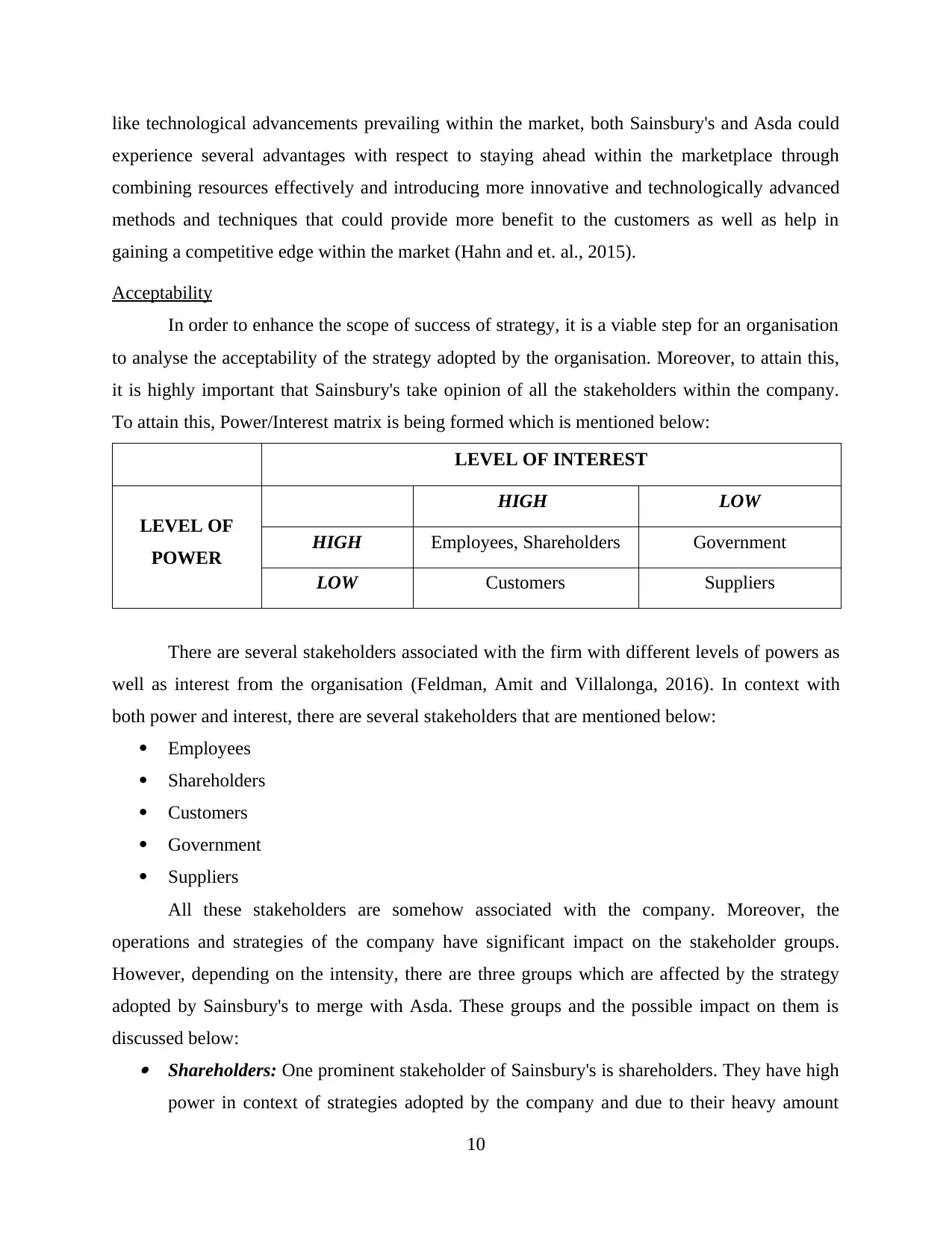
like technological advancements prevailing within the market, both Sainsbury's and Asda could
experience several advantages with respect to staying ahead within the marketplace through
combining resources effectively and introducing more innovative and technologically advanced
methods and techniques that could provide more benefit to the customers as well as help in
gaining a competitive edge within the market (Hahn and et. al., 2015).
Acceptability
In order to enhance the scope of success of strategy, it is a viable step for an organisation
to analyse the acceptability of the strategy adopted by the organisation. Moreover, to attain this,
it is highly important that Sainsbury's take opinion of all the stakeholders within the company.
To attain this, Power/Interest matrix is being formed which is mentioned below:
LEVEL OF INTEREST
LEVEL OF
POWER
HIGH LOW
HIGH Employees, Shareholders Government
LOW Customers Suppliers
There are several stakeholders associated with the firm with different levels of powers as
well as interest from the organisation (Feldman, Amit and Villalonga, 2016). In context with
both power and interest, there are several stakeholders that are mentioned below:
Employees
Shareholders
Customers
Government
Suppliers
All these stakeholders are somehow associated with the company. Moreover, the
operations and strategies of the company have significant impact on the stakeholder groups.
However, depending on the intensity, there are three groups which are affected by the strategy
adopted by Sainsbury's to merge with Asda. These groups and the possible impact on them is
discussed below: Shareholders: One prominent stakeholder of Sainsbury's is shareholders. They have high
power in context of strategies adopted by the company and due to their heavy amount
10
experience several advantages with respect to staying ahead within the marketplace through
combining resources effectively and introducing more innovative and technologically advanced
methods and techniques that could provide more benefit to the customers as well as help in
gaining a competitive edge within the market (Hahn and et. al., 2015).
Acceptability
In order to enhance the scope of success of strategy, it is a viable step for an organisation
to analyse the acceptability of the strategy adopted by the organisation. Moreover, to attain this,
it is highly important that Sainsbury's take opinion of all the stakeholders within the company.
To attain this, Power/Interest matrix is being formed which is mentioned below:
LEVEL OF INTEREST
LEVEL OF
POWER
HIGH LOW
HIGH Employees, Shareholders Government
LOW Customers Suppliers
There are several stakeholders associated with the firm with different levels of powers as
well as interest from the organisation (Feldman, Amit and Villalonga, 2016). In context with
both power and interest, there are several stakeholders that are mentioned below:
Employees
Shareholders
Customers
Government
Suppliers
All these stakeholders are somehow associated with the company. Moreover, the
operations and strategies of the company have significant impact on the stakeholder groups.
However, depending on the intensity, there are three groups which are affected by the strategy
adopted by Sainsbury's to merge with Asda. These groups and the possible impact on them is
discussed below: Shareholders: One prominent stakeholder of Sainsbury's is shareholders. They have high
power in context of strategies adopted by the company and due to their heavy amount
10
⊘ This is a preview!⊘
Do you want full access?
Subscribe today to unlock all pages.

Trusted by 1+ million students worldwide
1 out of 17
Related Documents
Your All-in-One AI-Powered Toolkit for Academic Success.
+13062052269
info@desklib.com
Available 24*7 on WhatsApp / Email
![[object Object]](/_next/static/media/star-bottom.7253800d.svg)
Unlock your academic potential
Copyright © 2020–2025 A2Z Services. All Rights Reserved. Developed and managed by ZUCOL.




